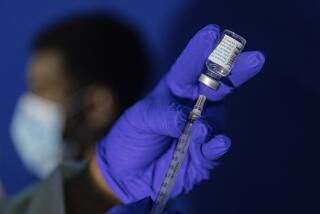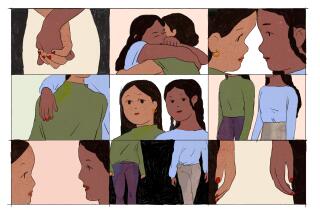Leprosy Nearly Eradicated, Africa Clinic to Turn to TB : Medicine: Ethiopian hospital adjacent to leper colony will target tuberculosis, closely linked to AIDS.
- Share via
ADDIS ABABA, Ethiopia — Awol Ahemed never noticed the patch of discolored skin on his arm, and only after his left hand had grown so numb that he could pick up a chunk of burning charcoal without feeling pain did he accept the awful truth: God had cursed him.
Gradually his hand became frozen in a claw-like position. Without pain as a protector, his fingers were constantly burned, cut and bruised and started to slowly wear away. Ulcers formed. And like everyone else with leprosy, Awol became an outcast, destined to forage for food and live alone in his Wollo province village.
A year ago Awol made his way to Addis Ababa, where he heard there was a hospital that would not turn him away. At the least, he had heard, he would be given soap, Vaseline, food. And near the hospital, people said, there was a huge leper colony where he would have to endure neither the stares nor the stigma of a disease scorned since biblical times.
The hospital he came to was the All-African Leprosy and Rehabilitation Training Center (ALERT), on 600 acres of lush grounds outside the Ethiopian capital. In operation since 1965, it is the only pan-African treatment facility for leprosy and is adjacent to the world’s largest leper colony, a ghastly village where 25,000 Africans--all lepers and their dependents--live without electricity, toilets or running water.
“Even my wife and children did not want to be close to me,” Awol said. “No one in my family ever had this disease, so it is clear God cursed me for some reason. Why, I do not know.”
For Awol, who is healing now after an operation to remove part of his hand, it is small consolation that the disease that has afflicted and deformed many millions of people, particularly in Africa and on the Asian subcontinent, is about to be defeated by modern medicine.
“Leprosy is dying as a disease,” said Neil Alldred, ALERT’s executive director. “It’s been knocked on its head--finished as a threat--by two drugs. By the year 2000, the World Health Organization says, leprosy should be eliminated as a public health problem.”
Dapsone, discovered in 1940, was effective in controlling the symptoms of leprosy but required lifelong use. The real breakthrough came in 1982, when two new drugs taken in pill form, Clofazimine and Rifampicin, were proved capable of stopping leprosy, even in advanced cases.
ALERT recently abandoned a 20-year survey of patients who suffered relapses after using the drug because the relapse rate is virtually nil. “There just wasn’t anything to study,” Alldred said. Since the drugs came into widespread use, ALERT’s caseload of patients with active leprosy has dropped from 23,000 to 1,200.
Despite popular beliefs, leprosy is not hereditary and is not passed by touching an open sore. It is a germ that destroys the nerves, usually in the hands or feet, and is spread when a leper coughs or sneezes or otherwise spreads the bacteria. A healthy body exposed to the germ will reject it with no ill effects.
Of the world’s 2.5 million lepers, almost all are in India and Africa. The vast majority live in unsanitary conditions and have inadequate diets and weak immune systems--characteristics that have made leprosy a disease of poverty.
The fact that leprosy is about to be eliminated as a health threat does not mean ALERT will soon close its 200-bed hospital or its training and rehabilitation center. The presence of the leper shantytown alone, Alldred said, is a daily reminder of medical failure--and of all that needs to be done to remove the stigma from the disease, treat the deformed and train the cured for some useful role in society.
ALERT will, however, change its emphasis and will deal primarily with tuberculosis, a disease closely associated with AIDS. First priority will be given to lepers with TB because the center would be inundated if it opened its doors to everyone who suffers from tuberculosis.
Five months ago the government estimated that 300,000 Ethiopians were HIV-positive. Last month it revised its estimate to 588,000. One reason for the higher figure: The end of a decade-long civil war has enabled more Ethiopians to reach clinics, which in turn report cases that previously went undetected.
Still, medical care remains so primitive that 55% of Ethiopians must walk for at least one day to reach the nearest clinic. The government’s new budget allocates only $2.10 per Ethiopian for health care--and 72% of that goes for salaries of medical personnel.
More to Read
Sign up for Essential California
The most important California stories and recommendations in your inbox every morning.
You may occasionally receive promotional content from the Los Angeles Times.













